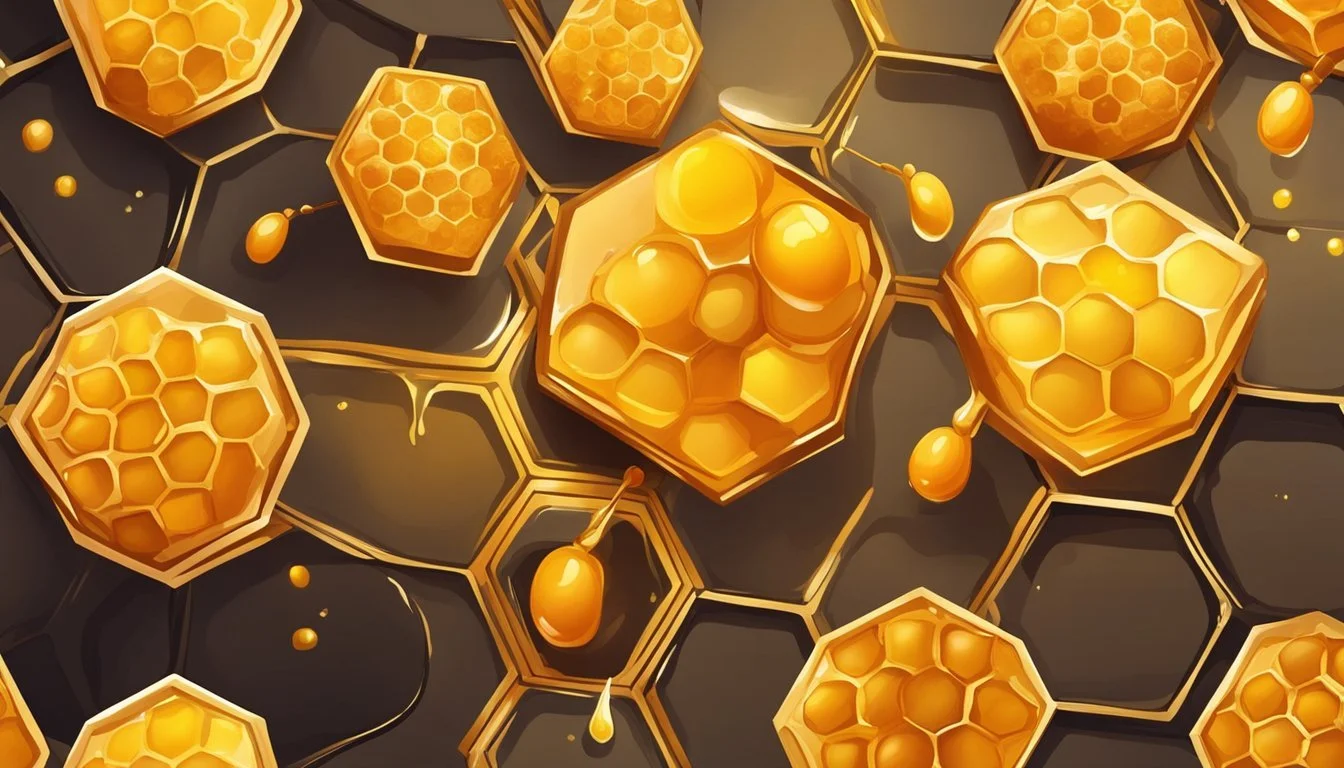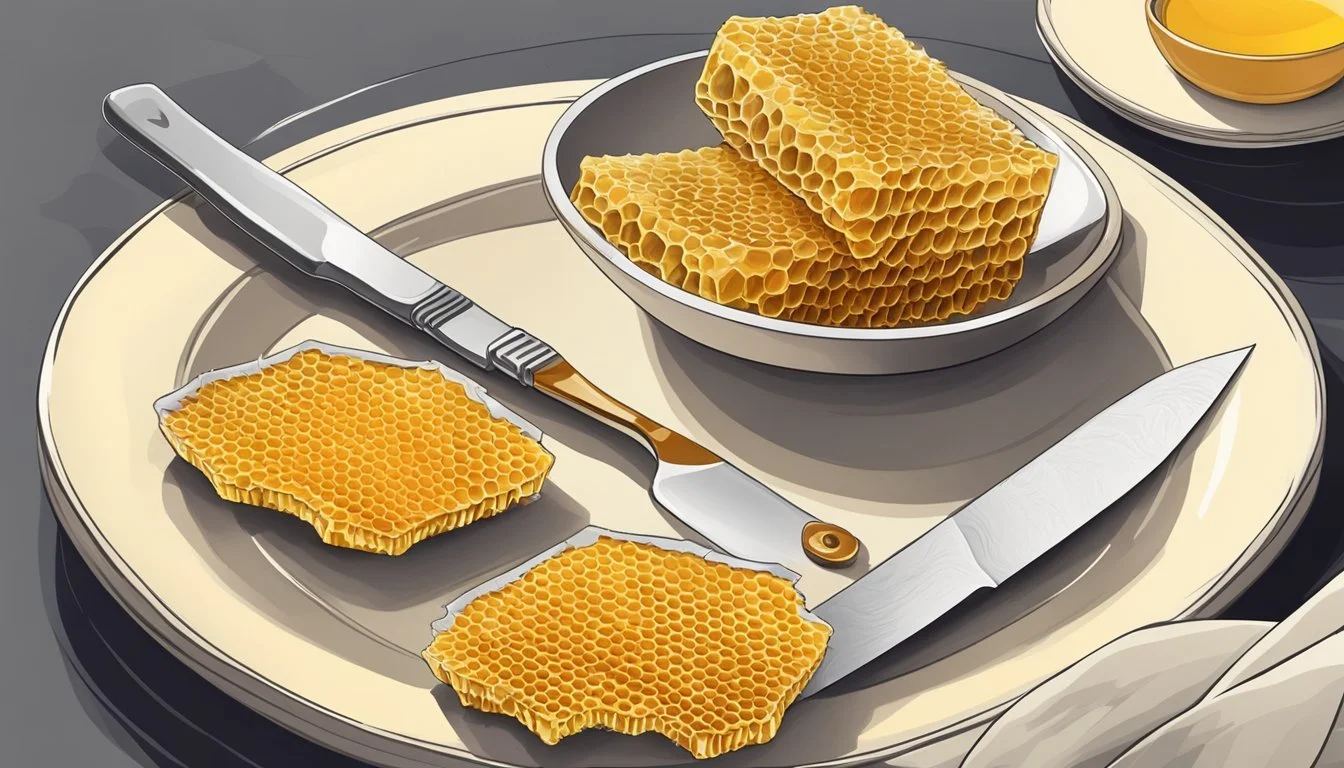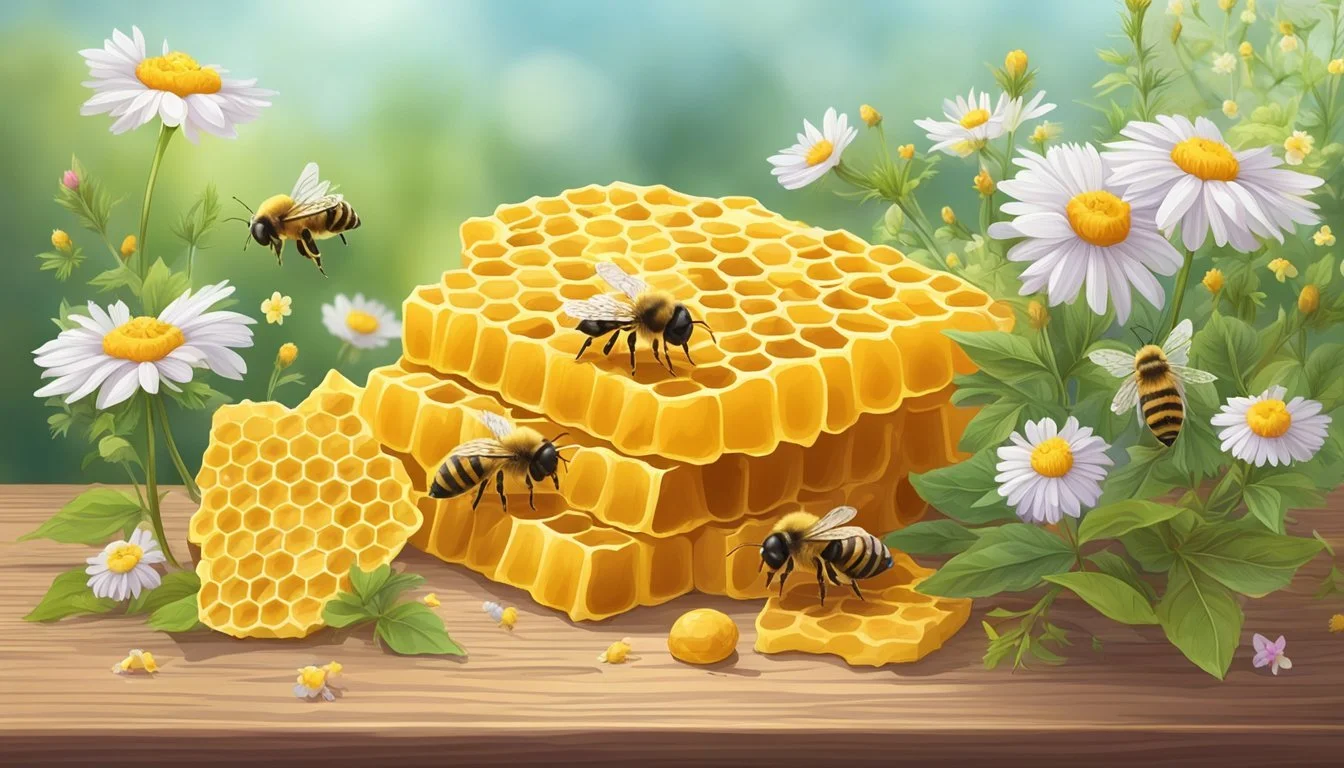How do you eat honeycomb?
Exploring the Sweet Delicacy
Honeycomb, the waxy hexagonal structure created by honeybees to store their honey (What wine goes well with honey?) and larvae, is not only a marvel of natural engineering but also a delicacy that can be enjoyed in various ways. It consists of both the honey and the wax cells, which are perfectly safe and even beneficial to consume. Each honeycomb cell is filled with raw honey, which retains its natural flavors and nutrients, making the comb a sought-after product for those looking to indulge in an unprocessed sweetener.
Eating honeycomb can be a delightful experience, serving as a unique addition to many dishes. The comb's texture adds a chewy contrast to the sweetness of the honey, elevating the sensory experience. The honey within the comb has a rich, nuanced flavor profile that varies depending on the flowers visited by the bees. It can be spread on warm bread or toast, where the heat gently melts the wax, infused into yogurt or ice cream for a hint of natural sweetness, or simply enjoyed on its own as an unadulterated treat.
Incorporating honeycomb into one's diet also brings with it the myriad benefits associated with raw honey, including the presence of enzymes, vitamins, and antioxidants. It's a versatile ingredient that complements and enhances the flavor of various foods, from the simplicity of a breakfast toast routine to the sophistication of a cheese platter. Moreover, honeycomb can be a conversation starter, acting as a centerpiece that sparks discussions about its origin and the remarkable efforts of the bees that produce it.
Understanding Honeycomb
Honeycomb is a natural product created by honey bees as part of the structure of a beehive. This intricate network of hexagonal cells made of beeswax serves multiple purposes for bees. Primarily, it is where bees store their honey and pollen, and it also serves as a nurturing space for their larvae.
The Structure of Honeycomb
Cells: Hexagonal in shape and consist of pure beeswax.
Function: Stores honey, pollen, and houses larvae.
Edibility
The entirety of the honeycomb is edible, from the raw honeycomb —which has a more textured consistency than filtered honey— to the waxy cells. Consuming honeycomb offers a unique taste experience, combining the sweetness of honey with the chewiness of the wax.
Honeycomb is harvested directly from the hive by a beekeeper. The process of extraction ensures that the comb can be removed without harming the bees or compromising the structure of the beehive.
Benefits of Honeycomb
Honey: A natural sweetener rich in sugars and nutrients.
Beeswax: While not as nutrient-dense as honey, it is still safe to eat.
In summary, honeycomb is not just an architectural marvel of the beehive but is also a delightful and edible byproduct of nature's diligent honey bees. It is a testament to the efficiency and resourcefulness of these pollinators, offering humans a glimpse into the complex world of bees and a taste of their labor.
Health Benefits of Honeycomb
Honeycomb is a natural product produced by honeybees and offers a range of health benefits due to its unique composition, which includes antibacterial properties, antioxidants, and nutrients that can contribute to heart health.
Nutritional Content
Honeycomb is rich in various nutrients that are essential for overall well-being. It is composed of long-chain fatty acids, vitamins, and enzymes. It also contains bee pollen and propolis, which are beneficial for health. Bee pollen is known for its protein content and vitamins, while propolis, a resinous mixture produced by bees, provides additional antibacterial qualities.
Vitamins: Essential for proper body function.
Enzymes: Aid in digestion and metabolism.
Bee Pollen: Contains proteins and micronutrients.
Propolis: Offers antibacterial benefits.
Antibacterial and Antioxidant Properties
The antibacterial properties of honeycomb are attributed to compounds such as propolis and royal jelly. Propolis, in particular, acts against bacteria, helping to reduce the risk of infections. Honeycomb also houses powerful antioxidants, including polyphenols, that combat oxidative stress in the body.
Propolis: Reduces bacterial activity.
Royal Jelly: Contains antibiotic elements.
Antioxidants: Polyphenols help in reducing oxidative damage.
Heart Health
Consumption of honeycomb may support heart health by influencing various heart-related factors. The antioxidants present in raw honey have been correlated with a decrease in the ability of platelets to form clots. Additionally, the content of honeycomb has been linked to raising levels of HDL (good) cholesterol and improving triglyceride profiles, which are important markers for cardiovascular health.
Reduce Clot Formation: Antioxidants in honey aid in preventing clots.
HDL Cholesterol: Honeycomb may help increase healthy cholesterol levels.
Triglycerides: Improved triglyceride levels contribute to heart health.
How to Eat Honeycomb
Eating honeycomb offers a unique experience with its rich flavor and texture. It is both sweet and chewy, and it can be enjoyed in various ways, either on its own or paired with other foods to enrich taste and provide a delightful contrast in flavors.
Direct Consumption
Honeycomb can be savored directly, with no additional preparation needed. Simply cut a small piece of the comb and chew it slowly to enjoy the burst of natural sweetness. As the honeycomb is at room temperature, it reaches the perfect balance between firmness and softness, making it an enjoyable eat. It's important to consume honeycomb in moderation, as it is high in sugar.
Pairing with Other Foods
Honeycomb's versatile nature allows it to complement a variety of foods, elevating their flavor profile:
Breakfast options: Enhance your morning routine by drizzling pieces of honeycomb over oatmeal, yogurt, or pancakes. It pairs exceptionally well with waffles, offering a natural sweetener.
Toasts: Spread chunks of honeycomb on warm bread, toast, or an English muffin to allow the heat to soften it, providing an exquisite texture.
Cheese boards: For a savory twist, add honeycomb to a cheese and charcuterie (What wine goes well with charcuterie?) board. The sweetness of the honeycomb pairs wonderfully with the saltiness of cheeses and the savoriness of cured meats (What wine goes well with cured meats?).
Fruit and salads: Combine honeycomb with fresh fruits or sprinkle over salads to add a sweet dimension that contrasts with the freshness of the produce.
Desserts: Top ice cream or crackers with honeycomb for an appetizing finishing touch.
Through pairing, honeycomb elevates the flavors of these foods, making it an excellent complement to various dishes.
Creative Uses in Recipes
Honeycomb is a versatile ingredient that enhances recipes with its unique texture and natural sweetness. It can be used in various culinary applications, from a natural sweetener to a decadent topping or an ingredient in baked goods.
As a Sweetener
Honeycomb serves as an excellent sweetener in beverages and dishes where a hint of honey's sweetness is desired. It can be melted into teas or infused in lemonade, adding a subtle, sweet flavor without overwhelming the drink. The honeycomb's natural sugar content also makes it a healthier alternative to processed sugars in recipes.
As a Topping
Honeycomb adds a sweet and chewy element when used as a topping. It pairs exceptionally well with:
Breakfast dishes: like pancakes, waffles, and oatmeal.
Toasts: including both sweet and savory versions, enhancing the toast's taste and texture.
Charcuterie boards: where it complements the flavors of various cheeses, nuts, and berries.
Sandwiches: particularly those that benefit from a touch of honey's flavor, such as a ham and Brie cheese sandwich.
The combination of honeycomb over a slice of warm, toasted bread is a simple pleasure, with the heat softening the honeycomb and making it easy to spread and enjoy.
In Baked Goods
Using honeycomb in baked goods incorporates a distinct flavor and sweetness:
Incorporate chunks of honeycomb into muffin or scone dough, to create pockets of honey flavor.
Mix into cookie or cake batters, where it will sweeten and moisten the final product.
Chefs should note that honeycomb's unique properties may affect the moisture content of their baked goods, thus adjustments to other ingredients might be necessary.
Safety and Precautions
When considering the consumption of honeycomb, it's essential to recognize potential health risks and necessary precautions, especially in relation to allergic reactions and specific vulnerable populations.
Allergic Reactions
Honeycomb can trigger allergic reactions in some individuals, particularly if they have allergies to bee venom or pollen. Symptoms might range from mild to severe and include hives, difficulty breathing, and anaphylaxis. Raw honey, found in honeycombs, retains its natural properties, including potential allergens that are typically removed in processed honey. Individuals with known allergies should consume honeycomb with caution and consult healthcare providers regarding their allergies before trying honeycomb.
Risks for Certain Groups
Certain groups should be particularly mindful of consuming honeycomb. Infants under one year old should avoid honeycomb due to the risk of botulism — a serious condition that can occur from bacteria found in soil and dust that can contaminate honey. Additionally, individuals with compromised immune systems, such as those battling or recovering from cancer or suffering from heart disease, might be at greater risk for adverse effects and should seek medical advice before consumption.
Pregnant women are typically advised to avoid any raw or unpasteurized foods, including raw honey found in honeycomb, due to the potential risk of exposure to bacteria that can harm the fetus. While honeycomb is generally safe to eat for the average adult, these populations should exercise caution and consult with healthcare professionals.
Storing Honeycomb
Storing honeycomb properly is essential to maintaining its quality and longevity. Honeycomb should be kept in an airtight container to guard against moisture, which honey naturally absorbs, leading to spoilage. The ideal place for storing honeycomb is at room temperature, away from direct sunlight or heat sources.
It is recommended to use a glass or plastic container with a tight lid for storage. This method prevents the honeycomb from drying out and ensures that it retains its delightful texture and taste.
Crystallization can occur in both honey and honeycomb, but this is a natural process and does not indicate spoilage. If the honey within the honeycomb does crystallize, placing the container in warm water can help return the honey to its liquid state.
Here is a concise checklist for storing honeycomb:
Ensure the container is airtight.
Store at room temperature (roughly 70°F or 21°C).
Avoid placing in areas with high humidity or near water.
Dark locations are preferable to prevent degradation from light.
By adhering to these storage guidelines, individuals can enjoy honeycomb at its best quality for an extended period. It's noteworthy that honeycomb has a naturally long shelf life due to its airtight cell structure, making it a convenient and resilient delicacy.
Where to Buy Honeycomb
When seeking to purchase honeycomb, buyers have the option of sourcing it locally from beekeepers, or conveniently through online retailers. Both avenues offer opportunities to find quality honeycomb, but they come with different experiences and potential benefits.
Local Sources
Local beekeepers are invaluable for consumers wanting to support local agriculture and obtain honeycomb fresh from the harvest. Purchasers can often visit farms or local markets to buy honeycomb directly. This approach not only bolsters the local economy but also provides a chance to learn about the beekeeping process and responsible harvesting practices firsthand. Here are a few places to consider:
Farmers Markets: Often, beekeepers will sell their honeycomb and other bee products at these community gatherings.
Local Beekeeping Farms: Visiting a beekeeping farm can provide insight into the process and allows buyers to purchase the freshest honeycomb.
Online Retailers
For convenience, online retailers offer a wide array of honeycomb options from various sources, including responsible beekeepers. When purchasing online, consumers can read reviews and check for certifications to ensure the quality of the honeycomb. It's important to verify that the beekeepers adhere to sustainable practices. Below is a guide to finding honeycomb online:
Specialty Stores: Websites dedicated to natural and organic products often stock honeycomb.
Large E-commerce Platforms: Platforms like Amazon provide a range of honeycomb products from different sellers.
Environmental Considerations
When consuming honeycomb, it's crucial to consider its environmental impact, particularly on honey bee populations and the importance of sourcing responsibly.
Bee Population Impact
Bees are essential for pollination and the health of many ecosystems. Eating honeycomb has a direct impact on bee populations. It consumes the bees' winter food stores and their space for egg-laying. Beekeepers must ensure that harvesting honeycomb does not detriment the hive's stability.
Responsible Sourcing
To ensure the protection of honey bees, consumers should opt for honeycomb from sources that prioritize bee welfare. Here are ways to identify responsibly sourced honeycomb:
Transparency: Look for beekeepers who are transparent about their harvesting methods.
Certifications: Seek out certifications that indicate sustainable and bee-friendly practices.
Support Local: Purchasing from local beekeepers can reduce the carbon footprint and support healthy bee populations in your area.
Concluding Remarks
Eating honeycomb is a unique experience that essentially combines two natural products: honey and beeswax. While honey offers a sweet, liquid treat, beeswax provides a chewy contrast. It's important for consumers to understand that the entire honeycomb is edible, and individuals can adjust their consumption habits based on personal preferences, such as choosing to spit out the wax after savoring the honey.
Some popular methods to enjoy honeycomb include:
Spreading chunks on warm, toasted bread
Incorporating it into a cheese platter for a mix of savory and sweet
Enjoying directly as a chewy snack
Finally, honeycomb is not merely a flavorful delight; it also boasts nutritional benefits. Packed with natural sugars and trace amounts of vitamins and antioxidants, it complements a balanced diet when consumed in moderation.
()()(*)
They should be aware that texture and flavor may vary depending on the flowers from which the bees have collected nectar, thereby offering a diverse range of taste experiences. As with all foods, moderation is key, and individuals with allergies to bees or honey products should proceed with caution.
Honeycomb stands out as a versatile, indulgent and wholesome food that individuals can incorporate into their diet in various delicious ways.





